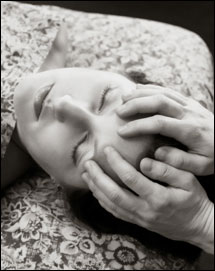What is Craniosacral Therapy?
 Craniosacral Therapy is a system of evaluation and treatment viewing the individual as an integrated totality and utilizing gentle, non-invasive mobilization techniques. As a result, the application of CST helps to enhance the body’s innate healing abilities.
Craniosacral Therapy is a system of evaluation and treatment viewing the individual as an integrated totality and utilizing gentle, non-invasive mobilization techniques. As a result, the application of CST helps to enhance the body’s innate healing abilities.
After some years of research, we now know that each of us has a craniosacral system inside that is rhythmically moving all the days we are alive. We have learned to monitor this craniosacral rhythm with our hands upon almost any part of a human body. Just as we are able to make certain inferences from heart rhythm and breathing activity about the cardiovascular and respiratory systems, we are now able to gather information about the condition and function of the craniosacral rhythm in and on various regions and parts of the human body.
When certain body parts or regions do not move rhythmically in response to the gentle urging of the craniosacral system, we are able to localize areas of trouble in the body. We don’t necessarily know what the trouble is, but we know where it is, and that is a powerful start in problem solving.
The craniosacral system itself is made up of: (1) the three-layered membrane system that we call the meninges; (2) the cerebrospinal fluid which is enclosed by this membrane system and (3) the structures within the membrane system that control fluid input and outflow for the system. What was just described is a semi-closed hydraulic system that uses the waterproof dura mater membrane (the outer layer of the three-layered membrane system) as its fluid enclosure barrier. It uses cerebrospinal fluid as the hydraulic component of the system. It uses the choroid system within the brain ventricles as the fluid input component, and it uses the arachnoid system as its fluid outflow component.
The powerful influence that the craniosacral system exercises upon total body function happens in large part because the system encloses the brain and spinal cord are more or less masters of your total nervous system, it is easy to see that the craniosacral system, by means of its effect upon the environment of the brain and spinal cord, has powerful influence over a wide variety of bodily functions. And via its influence upon the pituitary (master) gland and the pineal gland, the craniosacral system has a powerful effect upon the function of your endocrine system and the hormones that it secretes.
The membranous fluid barrier (dura mater) of the craniosacral system attaches to the bones of the skull on the inside. This dura mater membrane is actually the lining of the skull. It has been shown through research at Michigan State University by John Upledger that the skull bones must be in continual, minute motion in order to accommodate the constant fluid pressure changes that are going on within the membrane boundary of the semi-closed hydraulic system. When skull bones lose their ability to move in response to the changing pressures of the craniosacral system, the function of this system becomes compromised and symptoms may occur.
As CranioSacral Therapists we know about the attachments of the dura mater membranes to the skull bones, to the vertebrae of the upper neck, to the sacrum in the low back, and to all the little openings in the skull and vertebral column that allow passage for major nerves going to all parts of the body. We know how to find the areas of restricted movement that compromise craniosacral system function. And we know how to re-establish normal accommodation motion in all of these areas. In doing this work we are often able to improve the function of the nervous and endocrine systems by improving the environment in which these systems do their work.
What Conditions Does Craniosacral Therapy Address?
CranioSacral Therapy improves your body’s ability to take better care of you. It helps relieve a full spectrum of pain, illness and dysfunction, including:
- Migraines and Headaches
- Chronic Neck and Back Pain
- Stress and Tension –Related Disorders
- Motor-Coordination Impairments
- Infant and Childhood Disorders
- Brain and Spinal Cord Injuries
- Chronic Fatigue
- Fibromyalgia
- TMJ Syndrome
- Scoliosis
- Central Nervous System Disorders
- Learning Disabilities
- ADD/ADHD
- Post-Traumatic Stress Disorder
- Orthopedic Problems
- And Many Other Conditions
